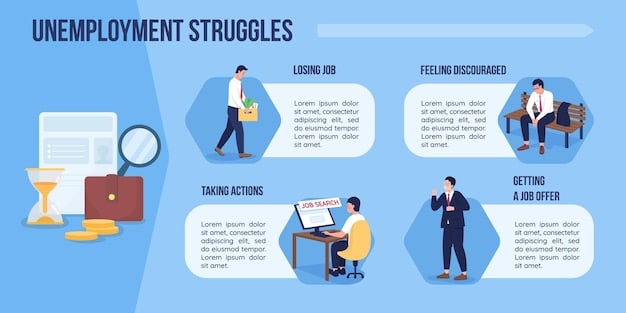The Ultimate Guide to Navigating US Unemployment Benefits in 2025

The Ultimate Guide to Navigating US Unemployment Benefits in 2025 provides comprehensive information on eligibility, application processes, and maximizing benefits. Stay informed about key changes and updates to the unemployment system to ensure you receive the support you deserve.
Navigating the complexities of unemployment benefits can be daunting, especially when facing job loss. In this comprehensive guide, we simplify the process and provide the information you need to understand and access US unemployment benefits in 2025.
Stay informed and empowered with The Ultimate Guide to Navigating US Unemployment Benefits in 2025, ensuring you are well-prepared to navigate the system and secure the financial support you deserve during times of unemployment.
Understanding US Unemployment Benefits in 2025
Unemployment benefits are a crucial safety net for individuals who have lost their jobs through no fault of their own. Understanding the basics of these benefits, including eligibility requirements and the application process, is essential for anyone facing unemployment in the US in 2025.
Eligibility Requirements for Unemployment Benefits
To be eligible for unemployment benefits, individuals generally need to meet certain criteria related to their prior work history, reason for unemployment, and availability to work. These requirements can vary by state, so it’s important to check the specific rules in your state. However some examples of the typical requirements are as follows:
- Job Loss: In most cases you have to have lost your job through no fault of your own.
- Prior Work History: Showing that you have a sufficient work history, including the amount of wages earned in the base year.
- Availability of Work: Confirming that you are able and available to accept suitable work.
Fulfilling these requirements is essential for accessing unemployment benefits in 2025.

How to Apply for Unemployment Benefits: A Step-by-Step Guide
The application process for unemployment benefits typically involves several steps, starting with gathering necessary documentation and filling out an application form. This process can be completed online for the most part. However seeking assistance may also be a good choice for some people facing unemployment.
Gathering Documentation
Before starting your application, it’s essential to gather all the required documentation, including your Social Security number, driver’s license or state ID, and employment history. Having these documents ready will streamline the application process.
Online Application Platforms for 2025
Most states now offer online application platforms for unemployment benefits, allowing individuals to apply from the comfort of their homes. These platforms provide step-by-step guidance and resources to help applicants navigate the process. Some platforms exist to help you navigate with a clearer understanding of the process:
- Simplifying complex concepts
- Acting as a personal assistant to gather information
- Giving you a place to see important updates relevant to your case
Navigating the application process may seem difficult at first, but you will be able to see the outcome within a short period after submitting the required information.
Maximizing Your Unemployment Benefits in 2025
To maximize your unemployment benefits, it’s important to understand how the benefit amount is calculated and what steps you can take to increase your eligibility and duration of benefits. Knowing all of the details can help those facing unemployment make the best informed decision moving forward.
Understanding Benefit Calculation Methods
Unemployment benefit amounts are typically calculated based on a percentage of your prior earnings, subject to a maximum weekly benefit amount. Understanding how this calculation works can help you estimate your potential benefits which can help you with your near term budget plans. Be sure to find out exactly how your specific state calculates these benefits.
Extending Benefit Duration
In times of high unemployment, some states may offer extended benefit duration beyond the standard period. Be sure to check with your state unemployment agency to see if extensions are available and what the requirements are for qualifying.
Maximizing benefits is essential in order to receive the most that you are eligible for.

Common Mistakes to Avoid When Claiming Unemployment
Claiming unemployment benefits involves following specific rules and procedures, and making mistakes can lead to delays or denials of benefits. Familiarizing yourself with common pitfalls and how to avoid them is crucial for a smooth application process.
Inaccurate Information on Application
Providing inaccurate or incomplete information on your application can raise red flags and potentially lead to delays or denials. Double-check all information before submitting your application to ensure accuracy.
Missing Deadlines
Unemployment agencies often have strict deadlines for filing claims, submitting documentation, and reporting job search activities. Missing deadlines can jeopardize your eligibility for benefits. Be sure to keep a calendar.
Appealing Denied Unemployment Claims
If your unemployment claim is denied, you have the right to appeal the decision. The appeals process typically involves submitting a written appeal, attending a hearing, and presenting evidence to support your claim. Make sure that you follow the right process and the correct deadlines to be able to receive unemployment benefits.
Preparing for the Appeal Hearing
Before the appeal hearing, gather all relevant documentation and evidence to support your claim. This may include employment records, termination letters, and witness statements. Be prepared to present your case clearly and persuasively.
Seeking Legal Assistance
Navigating the appeals process can be challenging, especially if you are unfamiliar with legal procedures. Consider seeking assistance from an attorney or legal aid organization to help you understand your rights and represent you at the hearing.
The appeals process varies by state, so be sure to seek all necessary clarification of the exact procedures.
The Future of Unemployment Benefits in the US
As the labor market evolves and technology advances, the landscape of unemployment benefits is likely to undergo significant changes in the coming years. Staying informed about these trends and potential reforms is crucial for individuals and policymakers.
Potential Legislative Reforms
Lawmakers may introduce legislative reforms to modernize and improve the unemployment system, addressing issues such as benefit adequacy, eligibility criteria, and program financing.
The Role of Technology in Unemployment Administration
Technology is playing an increasingly important role in the administration of unemployment benefits, from online application platforms to fraud detection systems. Embracing technology can help streamline the process and improve efficiency.
It is important to stay informed about the coming legislative reforms to be fully aware of all the possible changes.
| Key Point | Brief Description |
|---|---|
| 💼 Eligibility | Meet state-specific job loss and work history criteria. |
| 📝 Application | Gather documents, apply online, and meet deadlines. |
| 💰 Maximizing Benefits | Know calculation methods and look for extensions. |
| ⚖️ Appeals | Appeal if denied, gather evidence, and seek legal help. |
Frequently Asked Questions
Generally, you must have lost your job through no fault of your own, have a sufficient work history, and be available to accept suitable work. Specific requirements vary by state, so check your state’s guidelines.
Weekly benefits are typically calculated as a percentage of your prior earnings, up to a maximum amount. States have different formulas, but they often consider your earnings during a base period.
If your claim is denied, you have the right to appeal. Submit a written appeal, gather supporting documentation, and attend the appeal hearing. Consider seeking legal assistance if needed to better understand The Ultimate Guide to Navigating US Unemployment Benefits in 2025.
Generally, you are not eligible for unemployment benefits if you voluntarily quit your job without good cause. “Good cause” typically involves circumstances beyond your control that made continued employment unreasonable.
The duration of unemployment benefits varies by state but is typically around 26 weeks. During times of high unemployment, some states may offer extended benefits. Staying informed about the specifics allows you to use The Ultimate Guide to Navigating US Unemployment Benefits in 2025 wisely.
Conclusion
Navigating US unemployment benefits in 2025 requires a clear understanding of eligibility criteria, application procedures, and appeal processes. By staying informed and organized, you can maximize your chances of receiving the financial support you deserve during times of unemployment.
Remember to continuously monitor updates and potential changes to the unemployment system, as these can impact your eligibility and benefit amount. The Ultimate Guide to Navigating US Unemployment Benefits in 2025 is your tool to stay current.





